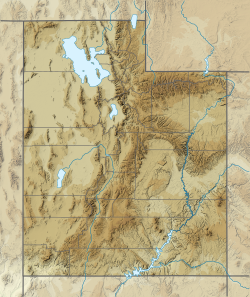| Topaz Mountain | |
|---|---|
 Topaz Mountain from the East | |
| Highest point | |
| Elevation | 7,052 ft (2,149 m) NAVD 88 [1] |
| Prominence | 706 ft (215 m) [2] |
| Coordinates | 39°42′34″N113°06′21″W / 39.709428906°N 113.105957406°W [1] |
| Geography | |
| Location | Juab County, Utah, U.S. |
| Parent range | Thomas Range |
| Topo map | USGS Topaz Mountain East |
Topaz Mountain is a summit in the Thomas Range of Utah, east of the Thomas caldera. The summit and surrounding area are known for their abundances of semiprecious minerals including topaz, red beryl and opal.


